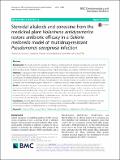Steroidal alkaloids and conessine from the medicinal plant Holarrhena antidysenterica restore antibiotic efficacy in a Galleria mellonella model of multidrug-resistant Pseudomonas aeruginosa infection
Abstract
Background This study aimed to evaluate the efficacy of combinations of steroidal alkaloids and conessine from the Thai medicinal plant Holarrhena antidysenterica with antibiotics against Pseudomonas aeruginosa strains possessing different efflux-pump-mediated multidrug-resistant (MDR) phenotypes in a Galleria mellonella infection model. Methods P. aeruginosa strains with defined mutations that result in the overexpression of the MexAB-OprM, MexCD-OprJ and MexEF-OprN efflux pumps, and a strain with all three of these pumps deleted, were used. In vitro, the effect of combinations of steroidal alkaloids and conessine with antibiotics was compared with antibiotic treatment alone via MIC determination and time-kill assays. Efficacy of combinations of the steroidal alkaloids and conessine with levofloxacin were compared with monotherapies against infections in G. mellonella larvae by measuring larval mortality and bacterial burden. Results Combination therapies of conessine or steroidal alkaloids with levofloxacin enhanced bacterial inhibition in vitro and restored antibiotic efficacy in vivo compared to the constituent monotherapies. Neither conessine nor the steroidal alkaloids induced any detectable toxicity in G. mellonella larvae. The enhanced efficacy of the combination treatments was most pronounced with conessine and correlated with reduced larval burden of infecting P. aeruginosa. Notably, the enhanced efficacy of conessine/levofloxacin combinations was only detected in the parent strain and strains that overexpressed the MexAB-OprM or MexEF-OprN efflux systems. Conclusions Steroidal alkaloids from Holarrhena antidysenterica, and particularly the principal active ingredient conessine, restored levofloxacin efficacy against resistant P. aeruginosa strains possessing efflux-mediated MDR phenotypes. The compounds should be investigated further as a potential novel therapy.
Citation
Siriyong , T , Voravuthikunchai , S P & Coote , P J 2018 , ' Steroidal alkaloids and conessine from the medicinal plant Holarrhena antidysenterica restore antibiotic efficacy in a Galleria mellonella model of multidrug-resistant Pseudomonas aeruginosa infection ' , BMC Complementary and Alternative Medicine , vol. 18 , 285 . https://doi.org/10.1186/s12906-018-2348-9
Publication
BMC Complementary and Alternative Medicine
Status
Peer reviewed
ISSN
1472-6882Type
Journal article
Description
This work was supported by the Thailand Research Fund through the Royal Golden Jubilee Ph.D. Program (Grant No. PHD/0041/2556) co-funded by the Newton Fund of the British Council and TRF Senior Research Scholar (Grant No. RTA 5880005).Collections
Items in the St Andrews Research Repository are protected by copyright, with all rights reserved, unless otherwise indicated.

